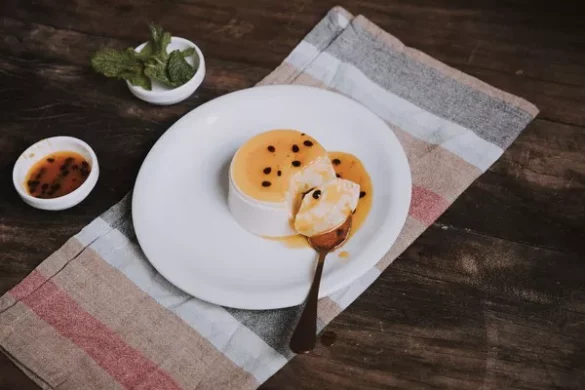Flan, a delightful and creamy dessert, has captivated taste buds around the world with its velvety texture and rich flavor. Originating from Spain, this beloved custard has taken on various forms and adaptations in different cultures. In this comprehensive exploration, we will unravel the mystery behind what makes flan so irresistible by delving into flans’ core ingredients, regional variations, and the cultural significance that makes it a timeless culinary treasure.
Understanding the Foundation: What is Flan Made Of?
At its essence, flan is a simple yet elegant dessert that revolves around a few key ingredients. Its base consists of eggs, sugar, and milk, creating a harmonious blend of flavors and textures. Let’s take a closer look at each component:
Eggs: The Heart of Flan
Eggs play a crucial role in flan, contributing to its smooth and custard-like consistency. The proteins in eggs coagulate during baking, providing structure to the dessert. Additionally, eggs bring a richness and a subtle savory note that balances the sweetness of the caramelized sugar.
Sugar: Crafting the Caramel
Caramelization is a defining element of flan, and sugar is the key player in this transformation. In the traditional preparation, sugar is melted and cooked until it turns golden brown, imparting a deep, slightly bitter flavor. This caramelized sugar is then poured into the mold before adding the custard mixture. As the flan bakes, the caramel forms a luscious sauce that envelops the dessert when inverted.
Milk: The Creamy Canvas
Milk serves as the liquid component of flan, creating a creamy and silky texture. Whole milk is commonly used, but variations may incorporate condensed milk, evaporated milk, or a combination of these. The choice of milk can influence the richness and sweetness of the final product, allowing for customization based on personal preferences.
See Also: Easy Flan Recipe (Only 5 Ingredients!)
Variations Across Continents:
As flan traveled across borders, it underwent fascinating transformations, adapting to local tastes and ingredients. Each variation adds a unique twist to the classic recipe, offering a diverse range of flavors and presentations.
Spanish Flan: The Original Elegance
The Spanish version of flan, known as “flan de huevo,” remains true to its roots. Made with eggs, sugar, and milk, it showcases the simplicity that defines the dish. Often flavored with vanilla, this flan epitomizes elegance, with its smooth texture and amber-hued caramel.
Mexican Flan: A Symphony of Flavors
In Mexico, flan has evolved into a cultural icon, incorporating influences from indigenous ingredients and culinary traditions. “Flan Mexicano” may feature a richer custard made with sweetened condensed milk and a touch of cinnamon. Some variations also include cream cheese or goat cheese for added depth and complexity.
Cuban Flan: A Tropical Twist
Cuban flan, or “flan de leche,” embraces the tropical flavors of the region. Coconut milk is often used in conjunction with regular milk, infusing the custard with a subtle coconut essence. This variation captures the essence of the Caribbean, offering a delightful departure from the classic recipe.
Filipino Leche Flan: A Sweet Legacy
In the Philippines, “leche flan” is a cherished dessert with a distinct character. It features a higher proportion of egg yolks, resulting in a more decadent and velvety custard. Often flavored with calamansi zest or vanilla, Filipino leche flan is frequently served during special occasions and celebrations.
Crème Caramel: French Elegance
While not called “flan” in France, the French version of this dessert, known as “crème caramel,” shares similarities. French crème caramel typically uses a lighter caramel and incorporates cream for a silkier texture. It exemplifies the refined and delicate nature of French desserts.
Cultural Significance of Flan:
Beyond its delectable taste and diverse variations, flan holds cultural significance in many societies. From festive celebrations to family gatherings, this dessert has become woven into the fabric of traditions, symbolizing sweetness, unity, and indulgence.
Celebrations and Festivities: A Symbol of Joy
Flan often takes center stage during celebrations and festive occasions. Its luxurious and indulgent nature makes it a perfect choice for birthdays, weddings, and holidays. The act of sharing a slice of flan becomes a symbolic gesture of joy and togetherness, connecting people through the pleasure of a shared dessert.
Family Traditions: Passed Down through Generations
Many families have cherished recipes for flan that are passed down from generation to generation. The process of preparing flan becomes a ritual, with each family member contributing to the creation of this beloved dessert. The act of making flan together reinforces familial bonds and preserves culinary traditions.
Culinary Fusion: Flan as a Global Ambassador
As flan transcends borders, it serves as a culinary ambassador, introducing people to the diverse flavors and traditions of different cultures. Its adaptability allows it to seamlessly integrate into various culinary landscapes, fostering cross-cultural appreciation and understanding.
Conclusion:
In the vast realm of desserts, flan stands out as a testament to the beauty of simplicity and the artistry of culinary alchemy. Whether enjoyed in its traditional Spanish form or in one of its many international variations, flan continues to captivate palates and hearts around the world. From the crackling sound of caramelization to the velvety embrace of the custard, flan remains a timeless dessert that transcends cultural boundaries, embodying the shared joy found in the act of savoring a beautifully crafted sweet treat.

